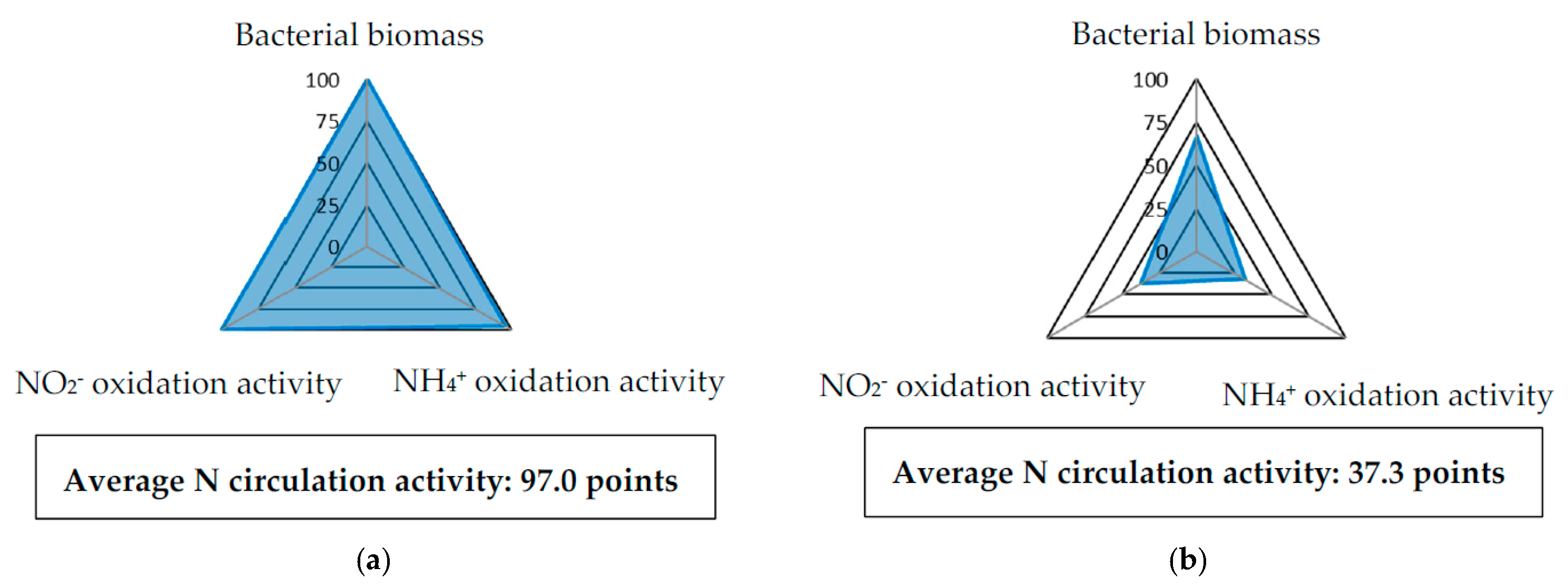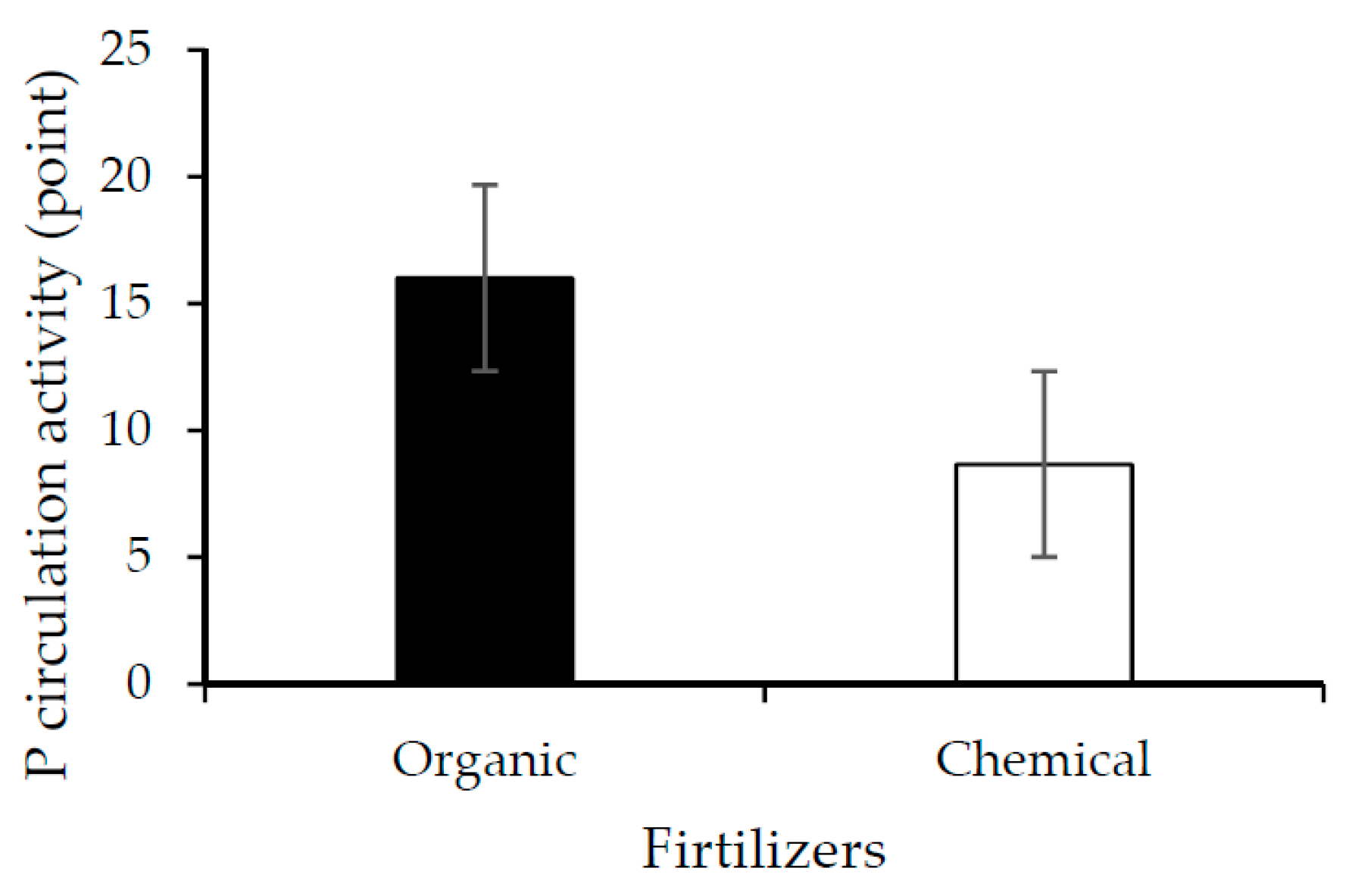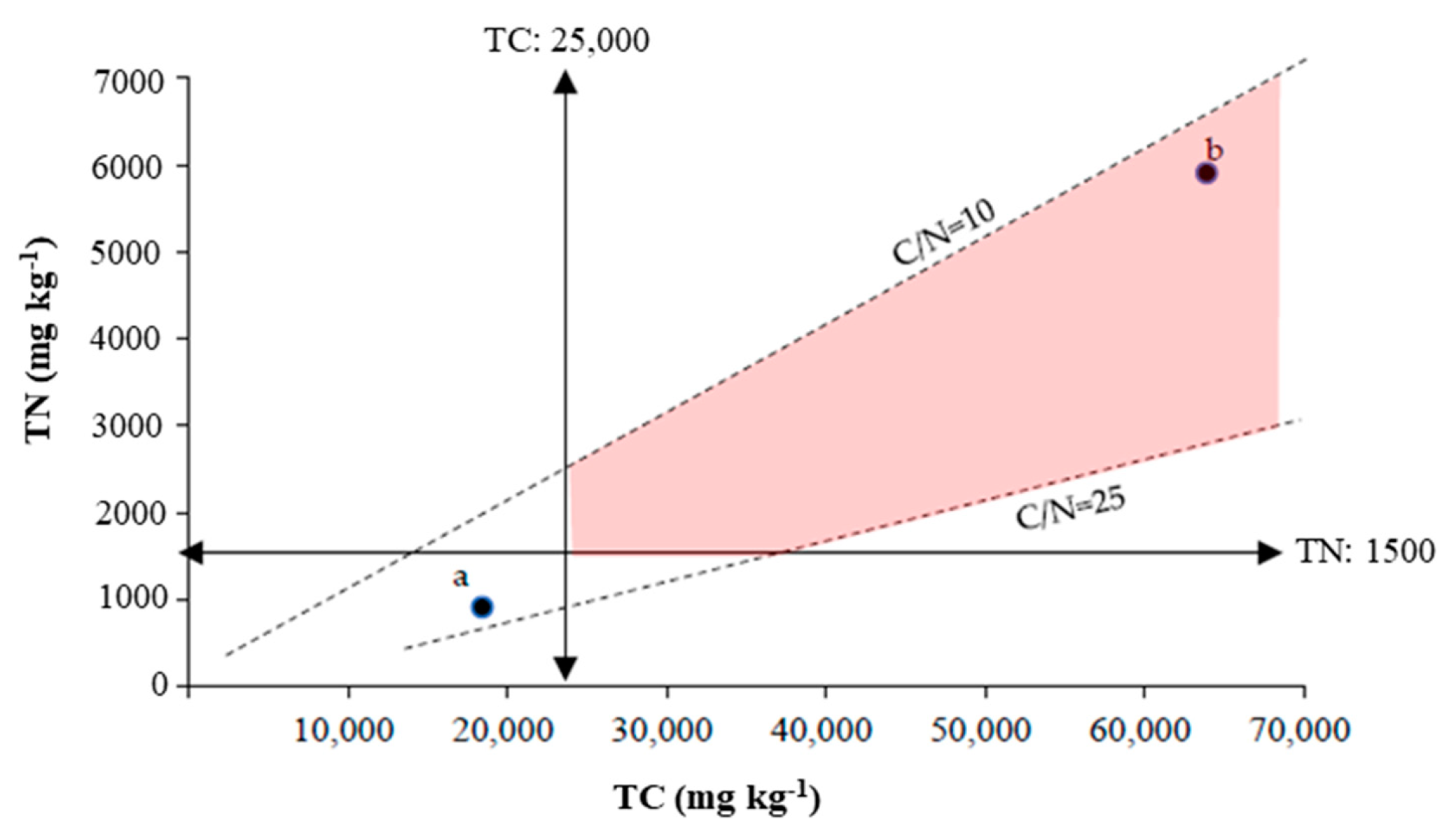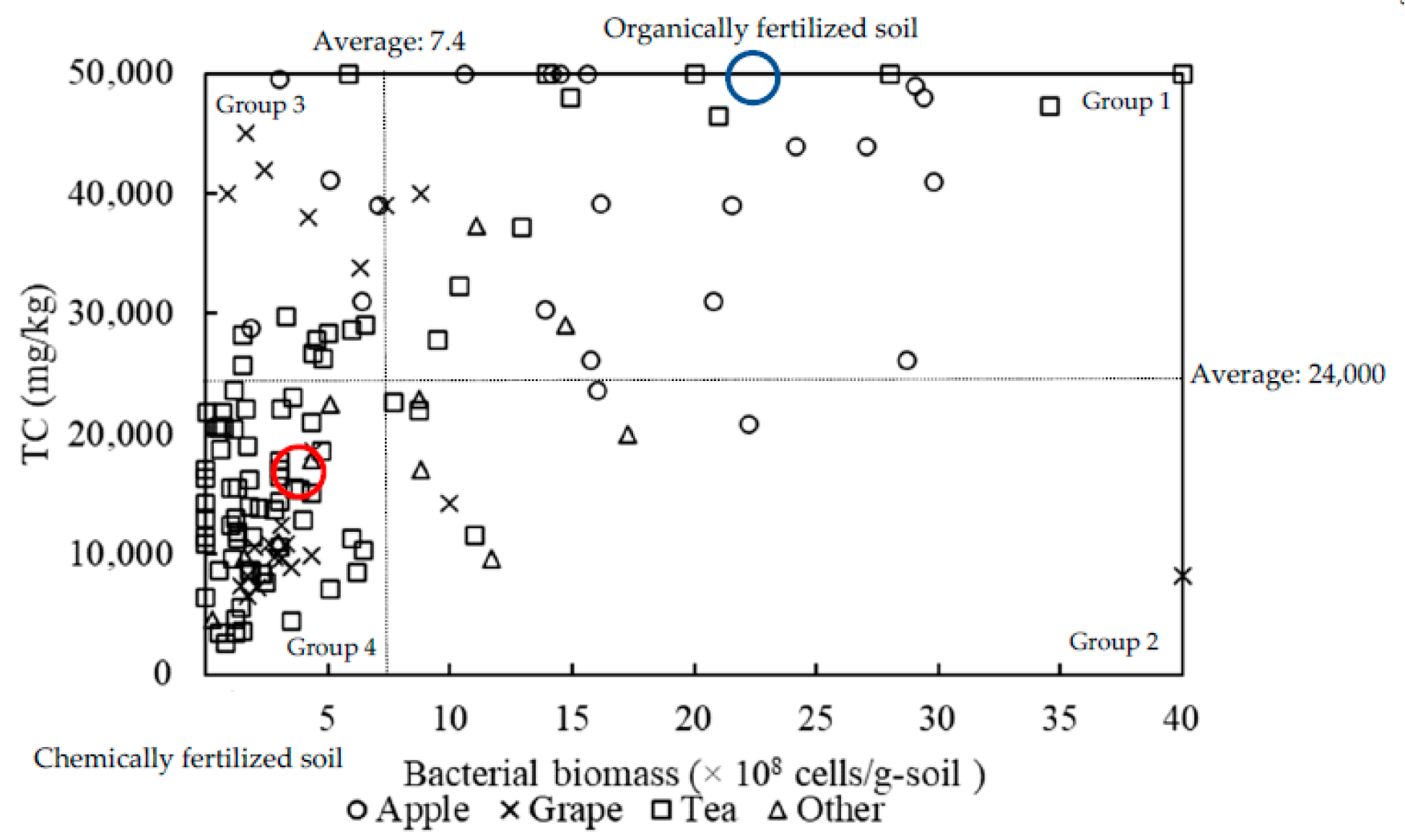Effect of Organic and Chemical Fertilizer Application on Apple Nutrient Content and Orchard Soil Condition
Abstract
:1. Introduction
2. Materials and Methods
2.1. Study Sites
2.2. Leaf and Fruit Nutrient Contents
2.3. Soil Sampling and Analysis for Physical and Chemical Properties
2.4. Soil Biological Properties
2.5. Pesticide Residues
2.6. Statistical Analysis
3. Results
3.1. Leaf Nutrient Content
3.2. Fruit Nutrient Content
3.3. Soil Physical and Chemical Properties
3.4. Soil Biological Properties
3.5. Pesticide Residues
4. Discussion
5. Conclusions
Author Contributions
Funding
Institutional Review Board Statement
Informed Consent Statement
Data Availability Statement
Conflicts of Interest
References
- Forsline, P.L.; Aldwinckle, H.S.; Dickson, E.E.; Luby, J.J.; Hokanson, S. Collection, maintenance, characterization, and utilization of wild apples of central Asia. Wild Apple Fruit Trees Cent. Asia 2003, 29, 1–62. [Google Scholar]
- Cornille, A.; Gladieux, P.; Smulders, M.J.M.; Roldán-Ruiz, I.; Laurens, F.; Le Cam, B.; Nersesyan, A.; Clavel, J.; Olonova, M.; Feugey, L.; et al. New insight into the history of domesticated apple: Secondary contribution of the European wild apple to the genome of cultivated varieties. PLoS Genet. 2012, 8, e1002703. [Google Scholar] [CrossRef] [Green Version]
- Food and Agricultural Organization of the United Nations. FAOSTAT: Crop Data. 2014. Available online: http://www.fao.org/faostat/en/#data/QC (accessed on 20 April 2015).
- Fujisawa, M.; Kobayashi, K. Shifting from apple to peach farming in Kazuno, northern Japan: Perceptions of and responses to climatic and non-climatic impacts. Reg. Environ. Chang. 2013, 13, 1211–1222. [Google Scholar] [CrossRef]
- Krishna, K.R. Agroecosystems: Soils, Climate, Crops, Nutrient Dynamics and Productivity; Apple Academic Press Inc.: Oakville, ON, Canada, 2014; pp. 1–552. [Google Scholar]
- The World of Organic Agriculture, Statistics and Emerging Trends; FiBL-IFOAM Report; Willer, H.; Lernoud, J. (Eds.) Research Institute of Organic Agriculture (FiBL), Frick, and IFOAM Organics International: Bonn, Germany, 2015; pp. 20–330. [Google Scholar]
- Reganold, J.P.; Glover, J.D.; Andrews, P.K.; Hinman, H.R. Sustainability of three apple production systems. Nat. Cell Biol. 2001, 410, 926–930. [Google Scholar] [CrossRef] [PubMed]
- de Ponti, T.; Rijk, B.; van Ittersum, M.K. The crop yield gap between organic and conventional agriculture. Agric. Syst. 2012, 108, 1–9. [Google Scholar] [CrossRef]
- Murphy, J.; Riley, J. A modified single solution method for the determination of phosphate in natural waters. Anal. Chim. Acta 1962, 27, 31–36. [Google Scholar] [CrossRef]
- Kai, T.; Kubo, M. Chemical and biological properties of apple orchard soils under natural, organic, hybrid, and conventional farming methods. J. Agric. Chem. Environ. 2020, 9, 134–146. [Google Scholar] [CrossRef]
- Swezey, S.L.; Werner, M.R.; Buchanan, M.; Allison, J. Comparison of conventional and organic apple production systems during three years of conversion to organic management in coastal California. Am. J. Altern. Agric. 1998, 13, 162–180. [Google Scholar] [CrossRef]
- Peck, G.M.; Andrews, P.K.; Reganold, J.P.; Fellman, J.K. Apple orchard productivity and fruit quality under organic, conventional, and integrated management. HortScience 2006, 41, 99–107. [Google Scholar] [CrossRef] [Green Version]
- Kai, T.; Kumano, M.; Tamaki, M. A study on rice growth and soil environments in paddy fields using different organic and chemical fertilizers. J. Agric. Chem. Environ. 2020, 9, 331–342. [Google Scholar] [CrossRef]
- Kai, T.; Nishimori, S.; Tamaki, M. Effect of organic and chemical fertilizer application on growth, yield, and quality of small-sized tomatoes. J. Agric. Chem. Environ. 2020, 9, 121–133. [Google Scholar] [CrossRef]
- Kai, T.; Tamaki, M. Effect of organic and chemical fertilizer application on growth, yield, and soil biochemical properties of landrace Brassica napus L. leaf-and-stem vegetable and landrace (Norabona). J. Agric. Chem. Environ. 2020, 9, 314–330. [Google Scholar] [CrossRef]
- Kubo, M.; Adhikari, D.; Araki, S.K.; Kubota, K.; Shinozaki, A.; Matsuda, F.; Mitsukoshi, K.; Mukai, M.; Watarai, H. The Science of Soil Making; Seibundo-Shinkosha Co. Ltd.: Tokyo, Japan, 2017; pp. 10–159. [Google Scholar]
- Kai, T.; Adhikari, D.; Kubo, M. Soil preparation based on biological properties. J. Water Land Environ. Eng. 2017, 85, 927–930. [Google Scholar]
- Kai, T.; Mukai, M.; Araki, S.K.; Adhikari, D.; Kubo, M. Physical and biological properties of apple orchard soils of different productivities. Open J. Soil Sci. 2015, 5, 149–156. [Google Scholar] [CrossRef] [Green Version]
- Japan Meteorological Agency. Historical Weather Data. Available online: https://www.data.jma.go.jp/obd/stats/etrn/index (accessed on 28 February 2021).
- Nagano Agriculturadministration Department. Fertilizers and Pesticides. Available online: https://www.pref.nagano.lg.jp/nogi/sangyo/nogyo/hiryo/ (accessed on 25 February 2021).
- Secretariat, Council of Agriculture, Forestry and Fisheries Technology, Ministry of Agriculture, Forestry and Fisheries. Revised Standard Soil Color Charts; Fujihira Industry Corporation: Tokyo, Japan, 2010. [Google Scholar]
- Nicholas, D.D.; Nason, A. Determination of nitrate and nitrite. Methods Enzymol. 1957, 3, 981–984. [Google Scholar] [CrossRef]
- Aoshima, H.; Kimura, A.; Shibutani, A.; Okada, C.; Matsumiya, Y.; Kubo, M. Evaluation of soil bacterial biomass using environmental DNA extracted by slow-stirring method. Appl. Microbiol. Biotechnol. 2006, 71, 875–880. [Google Scholar] [CrossRef] [PubMed]
- Matsuno, T.; Horii, S.; Fukuhara, Y.; Matsumiya, Y.; Kubo, M. Nitrogen control and soil preparation visualization of nitrogen cycle in agricultural land-soil preparation considering ma-terial circulation system. Soil Prep. Eco-Friendly 2012, 44, 50–55. [Google Scholar]
- Horii, S.; Matsuno, T.; Tagomori, J.; Mukai, M.; Adhikari, D.; Kubo, M. Isolation and identification of phytate-degrading bacteria and their contribution to phytate mineralization in soil. J. Gen. Appl. Microbiol. 2013, 59, 353–360. [Google Scholar] [CrossRef] [PubMed] [Green Version]
- Ishibashi, M.; Ando, T.; Sakai, M.; Matsubara, A.; Uchikata, T.; Fukusaki, E.; Bamba, T. High-throughput simultaneous analysis of pesticides by supercritical fluid chromatography/tandem mass spectrometry. J. Chromatogr. A 2012, 1266, 143–148. [Google Scholar] [CrossRef] [PubMed]
- Ministry of Health, Labour, and Welfare. Residual Pesticides in Food, etc. Available online: https://www.mhlw.go.jp/stf/seisakunitsuite/bunya/kenkou_iryou/shokuhin/zanryu/index.html (accessed on 28 February 2021).
- Yao, H.; He, Z.L.; Wilson, M.; Campbell, C.D. Microbial biomass and community structure in a sequence of soils with in-creasing fertility and changing land use. Microb. Ecol. 2000, 40, 223–237. [Google Scholar] [CrossRef]
- Flanagan, P.W.; Van Cleve, K. Nutrient cycling in relation to decomposition and organic-matter quality in taiga ecosystems. Can. J. For. Res. 1983, 13, 795–817. [Google Scholar] [CrossRef]
- Kubo, M. Agriculture Based on Material Circulation: Indicator for Organic Agriculture, Reduction of Agrochemicals; Kyoritsu Co., Ltd.: Tokyo, Japan, 2020; pp. 1–175. [Google Scholar]
- Kubo, M.; Horii, S.; Matsuno, T.; Mukai, M.; Adhikari, D. Evaluation of soil fertility for plant growth based on bacterial biomass and material circulation in soil environment. In Recent Development in Biotechnology, Fertilizer Technology II, Biofertilizers; Govil, J.N., Ed.; Studium Press LLC: Houston, TX, USA, 2015; pp. 147–160. [Google Scholar]
- Tully, K.; Ryals, R. Nutrient cycling in agroecosystems: Balancing food and environmental objectives. Agroecol. Sustain. Food Syst. 2017, 41, 761–798. [Google Scholar] [CrossRef]
- Wutzler, T.; Zaehle, S.; Schrumpf, M.; Ahrens, B.; Reichstein, M. Adaptation of microbial resource allocation affects modelled long term soil organic matter and nutrient cycling. Soil Biol. Biochem. 2017, 115, 322–336. [Google Scholar] [CrossRef]
- Pitchayapa, P.; Quoc, T.T.; Takamitsu, K.; Taiki, K.; Kenzo, K.; Kiwako, S.A.; Motoki, K.; Pholkaw, P.; Tran, Q.T.; Kai, T.; et al. Characterization of orchard fields based on soil fertility index (SOFIX). J. Agric. Chem. Environ. 2020, 9, 159–176. [Google Scholar] [CrossRef]
- Katayama, N.; Osada, Y.; Mashiko, M.; Baba, Y.G.; Tanaka, K.; Kusumoto, Y.; Okubo, S.; Ikeda, H.; Natuhara, Y. Organic farming and associated management practices benefit multiple wildlife taxa: A large-scale field study in rice paddy landscapes. J. Appl. Ecol. 2019, 56, 1970–1981. [Google Scholar] [CrossRef]



 ) organic and (
) organic and (  ) conventional farming systems in the current study (n = 2).
) conventional farming systems in the current study (n = 2).
 ) organic and (
) organic and (  ) conventional farming systems in the current study (n = 2).
) conventional farming systems in the current study (n = 2).
| Experimental Treatments | TC (mg kg−1) | TN (mg kg−1) | TP (mg kg−1) | TK (mg kg−1) |
|---|---|---|---|---|
| Organic fertilizer | 464,667 ± 8087 z | 10,997 ± 150 | 1245 ± 18 | 6149 ± 332 |
| Chemical fertilizer | 485,433 ± 4879 | 9943 ± 514 | 1503 ± 146 | 7491 ± 1603 |
| LSD-test y | * | * | n.s. | n.s. |
| Experimental Treatments | TC (mg kg−1) | TN (mg kg−1) | TP (mg kg−1) | TK (mg kg−1) | Sugar (Brix%) | Acidity (%) | Sugar–Acidity Ratio |
|---|---|---|---|---|---|---|---|
| Organic fertilizer | 76,283 ± 9237 z | 518 ± 37 | 483 ± 121 | 2250 ± 842 | 16.0 ± 1.9 | 0.41 ± 0.17 | 39.0 ± 22.9 |
| Chemical fertilizer | 84,200 ± 16,985 | 480 ± 28 | 367 ± 124 | 2833 ± 205 | 14.5 ± 2.0 | 0.38 ± 0.26 | 38.2 ± 17.8 |
| LSD-test y | n.s. | n.s. | n.s. | n.s. | ** | n.s. | n.s. |
| Experimental Treatments | TC (mg kg−1) | TN (mg kg−1) | TP (mg kg−1) | TK (mg kg−1) | C/N Ratio (%) | NO3--N (mg kg−1) | NH4+-N (mg kg−1) | Soluble P (mg kg−1) | Soluble K (mg kg−1) | pH | EC (mS cm−1) |
|---|---|---|---|---|---|---|---|---|---|---|---|
| Organic fertilizer | 63,917 ± 14,698 z | 5906 ± 1658 | 19,368 ± 5090 | 5011 ± 535 | 10.8 ± 0.7 | 66.0 ± 27.4 | 1.7 ± 0.5 | 222 ± 76 | 413 ± 141 | 6.9 ± 0.1 | 0.33 ± 0.12 |
| Chemical fertilizer | 18,447 ± 5227 | 911 ± 262 | 6132 ± 397 | 6789 ± 101 | 20.2 ± 1.4 | 19.0 ± 25.5 | 6.0 ± 4.1 | 114 ± 37 | 181 ± 55 | 7.6 ± 0.2 | 0.39 ± 0.39 |
| LSD-test y | * | * | * | * | ** | n.s. | n.s. | n.s. | n.s. | * | n.s. |
| Experimental Treatments | Bacterial Biomass (×108 Cells g−1) | NH4+ Oxidation Activity (Point) | NO2− Oxidation Activity (Point) | N Circulation Activity (Point) | P Circulation Activity (Point) |
|---|---|---|---|---|---|
| Organic fertilizer | 23.6 ± 1.7 z | 95.7 ± 6.1 | 99.8 ± 0.2 | 97.0 ± 4.2 | 16.0 ± 3.7 |
| Chemical fertilizer | 4.0 ± 3.2 | 32.3 ± 9.2 | 37.3 ± 44.6 | 13.7 ± 7.6 | 8.7 ± 7.4 |
| LSD-test y | ** | ** | n.s. | ** | n.s. |
| Experimental Treatments | Propargite (mg kg−1) | Trifloxystrobin (mg kg−1) | Acetamiprid (mg kg−1) | Boscalid (mg kg−1) | Acrinathrin (mg kg−1) |
|---|---|---|---|---|---|
| Organic fertilizer | N.D ± 0.00 z | 0.01 ± 0.00 | 0.02 ± 0.00 | N.D ± 0.00 | N.D ± 0.00 |
| Chemical fertilizer | 0.37 ± 0.01 | 0.07 ± 0.01 | 0.03 ± 0.00 | 0.01 ± 0.00 | 0.01 ± 0.00 |
| LSD-test y | * | * | n.s. | n.s. | n.s. |
| Residual pesticide standards | |||||
| Japan (mg kg−1) | <5 | <3 | <2 | <2 | <0.7 |
| EU (mg kg−1) | <0.01 | <0.7 | <0.4 | <2 | <0.02 |
| Codex (mg kg−1) | <3 | <0.7 | <0.8 | <2 | - |
| China | <5 | <0.7 | <0.8 | <2 | - |
| Korea | <5.0 | <0.7 | <0.3 | <1.0 | 0.5 |
Publisher’s Note: MDPI stays neutral with regard to jurisdictional claims in published maps and institutional affiliations. |
© 2021 by the authors. Licensee MDPI, Basel, Switzerland. This article is an open access article distributed under the terms and conditions of the Creative Commons Attribution (CC BY) license (https://creativecommons.org/licenses/by/4.0/).
Share and Cite
Kai, T.; Adhikari, D. Effect of Organic and Chemical Fertilizer Application on Apple Nutrient Content and Orchard Soil Condition. Agriculture 2021, 11, 340. https://doi.org/10.3390/agriculture11040340
Kai T, Adhikari D. Effect of Organic and Chemical Fertilizer Application on Apple Nutrient Content and Orchard Soil Condition. Agriculture. 2021; 11(4):340. https://doi.org/10.3390/agriculture11040340
Chicago/Turabian StyleKai, Takamitsu, and Dinesh Adhikari. 2021. "Effect of Organic and Chemical Fertilizer Application on Apple Nutrient Content and Orchard Soil Condition" Agriculture 11, no. 4: 340. https://doi.org/10.3390/agriculture11040340
APA StyleKai, T., & Adhikari, D. (2021). Effect of Organic and Chemical Fertilizer Application on Apple Nutrient Content and Orchard Soil Condition. Agriculture, 11(4), 340. https://doi.org/10.3390/agriculture11040340





